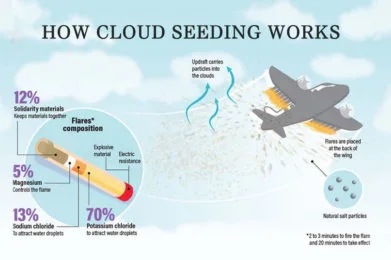ARTIFICIAL RAIN (CLOUD SEEDING)
Delhi’s air quality has shown no signs of improvement affected severely by stubble burning. The quality is only set to deteriorate further in the coming days New Delhi NCR is toying with the idea of Artificial Rain to clean pollution in Delhi.
With air pollution being an issue in the NCR, the Ministry of Environment, Forest and Climate Change has approved inducing artificial rain by cloud-seeding. The process will be carried out jointly by the Central Pollution Control Board (CPCB) in association with the Indian Institute of Technology – Kanpur.
It is expected to wash away the pollutants in the air and help curb the alarming levels of pollution, a major threat to public health today.

How is it done?
Cloud seeding attempts to stimulate natural precipitation processes by injecting nucleating agents into clouds, typically from aircraft. It is observed that even in dry regions, there is no dearth of clouds. The problem is that they do not produce rain. There are two reason why clouds do not produce rain—
(i) The droplets do not grow large enough to initiate coalescence, and
(ii) The temperature is not low enough (below -10oC) to produce ice crystals naturally. These reasons must be overcome to produce rain. This can be done by artificially introducing some nuclei, which will induce ice crystal formation. These nuclei can be silver iodide or dry ice.

Silver iodide is a substance, which has crystal properties similar to those of ice. By dropping silver iodide into the cloud, the Bergeron process is stimulated. When silver iodide is dropped into a cloud ice crystals form around them or they collide with and freeze some of the cloud droplets. These ice particles grow large enough to initiate coalescence, even when the temperature is as high as –4°C. Sometimes cold clouds are dioxide and has a temperature of about –80°C. Thus, when dry ice falls through a cloud they cool the nearby air to well below –10° C; it then encourages the natural freezing nuclei and activates the Bergeron process. In warm clouds, sea salt crystals and other hygroscopic substances are injected to encourage the growth of few large drops, which then can fall to the ground. The statistical significance of the result is hard to assess and there is lack of undisputed evidence. Careful studies have shown that when clouds are seeded properly, precipitation increases by 10-20 per cent but the question remains, would the rain or snow that follows would have fallen anyway?

Cloud seeding is not always successful. If too many ice crystals are produced as a result of seeding, none will be able to grow large enough to start coalescence. There is, therefore, always a possibility that if cloud seeding is overdone it can actually prevent a cloud from producing precipitation. This form of over seeding can be a consequence of excessive air pollution. If over seeded, the growth of large destructive hailstones can be checked. Even if successful, cloud seeding on a large geographical scale may merely redistribute a fixed supply of rain. An increase in precipitation in one area might mean a compensative reduction in another.
Is it safe?
There are also some problems in cloud seeding—
1.It does not work in very dry areas where it is most needed because there are rarely any clouds available.
2.There could be serious ecological side effects, including
(a) the unknown effects of silver iodide on human beings and wildlife,
(b) changes in original snowfall and rainfall,
(c) additional flooding that could alter or destroy vegetation and wildlife.
3.Cloud seeding, meant for a particular dry area, may bring rainfall to other already wet area.
Cloud seeding can also occur naturally, when ice crystals from cirrus clouds fall into the stratus clouds below, thus, increasing precipitation.
The link to join the course : Online Courses
Has it been practiced before?
Artificial rain is nothing new for India. According to the Indian Institute of Tropical Metrology, the first attempt at artificial rain in India was made by the Tata firm in 1951 using a ground-based silver iodide generator on the Western Ghats.
After this, attempts for artificial rain have been made in India in Karnataka (2003, 04, 2019), Andhra Pradesh (2008), Maharashtra (2004), Tamil Nadu (1983, 1993, 94).
However, artificial rain was made to deal with drought in these states.
Till last year, IMD has a record of about 30 successful seeding events.
Will it be effective?
Although artificial is expected to help with the problem of air pollution, there are several concerns
Cloud-seeding might give relief from air pollution for a short period by washing down the pollutants from the air but for how long?
In 2 or 3 days, the toxic smog will be back, and then what?
It is nowhere near a solution to pollution we need to trap pollutants at the source and come up with a sustainable solution to curb air pollution.
This is however a short-term measure, but once successful may become a long-term term too.
Best Online Coaching for Civil Service_IAS_ UPSC_IFS_IPS
Free Study Material ENSEMBLE IAS ACADEMY | Call +91 98115 06926
Visit us:- https://ensembleias.com/ | Online Store: https://online.ensemble.net.in/
#cloud_seeding #artificial_rain #pollution #pollution_issue_NCR #delhi #weather_modification #cloud_condensation #ice_nuclei #microphysical_processes #Environment #Forest #Climate Change #civil_services_study #ensemble_ias_academy #geography_optional #k_siddharthasir #ias #upsc_exam #civilservices #upsc_motivation #upsc_aspirants #trendsingeography




